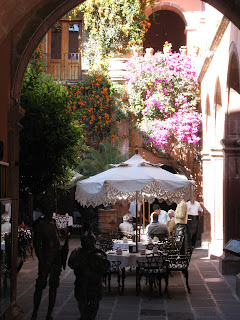

Well, I made it. The alarm I downloaded onto my laptop worked just fine and I got myself out of bed at 6 a.m. yesterday in Veracruz. Found a cab on the street, and got to the airport on time. The flight was uneventful (the way we like 'em) with a connection in Mexico City, then on to Tuxtla Guiterrez (the capital of Chiapas state). Now that says something about the hub-and-spoke system of the airlines, because I FLEW IN THE OPPOSITE DIRECTION from where I wanted to go. I headed back west to Mexico, then on the connecting flight returned east and south...past Veracruz to Tuxtla Guiterrez. There is evidently no direct service between the 2 cities. Tuxtla is down in the lowlands and is a big ugly modern city which is hotter 'n hell in the summer. I took a bus 1.5 hours up the mountain to San Cristobal.
This little town is pretty like San Miguel de Allende, but without so many tourists. Those tourists who are here are largely European. Right now I'm sitting in an Italian Coffee Company franchise coffeeshop, on my laptop. They have WI-FI Internet access for customers. The only other folks in here are a table of 12 large and noisy Germans. Eating cake and coffee, naturally. They look like nothing so much as a bunch of American Midwesterners, all ruddy faced and big. One lady did the "Gerta, now did you have the coffee cake or the chocolate torte" routine and divided up the bill 12 ways. It was fun to watch.
I'm staying at a very nice Posada. It has a family home atmosphere. The landlady lives there and has 5 guest rooms she rents out. I have use of the kitchen (for the first time), which is nice so I don't have to eat every meal out. I've got color cable TV in my room, private bath and plenty of hot water. The owner lady is very friendly and helpful.
Today, my big errands were getting a haircut and picking up my laundry. That's enough for a day. I also discovered the local farmers's market. These are among my favorite places....the sights, sounds, and smells. Once I get oriented, I want to dig into those incredible looking vegetables from the market. Maybe a nice vegetable soup? But there is stuff there I've never seen before.
I went to the Cultural Center today, and they have a mass choral concert coming up on Dec. 1. I wouldn't miss it for the world. The singers are from area universities and the groups are called "tunas" not choruses. I understand it comes from the Spanish troubadour tradition. Men in tights and capes, even.
Happy Thanksgiving to you all.












